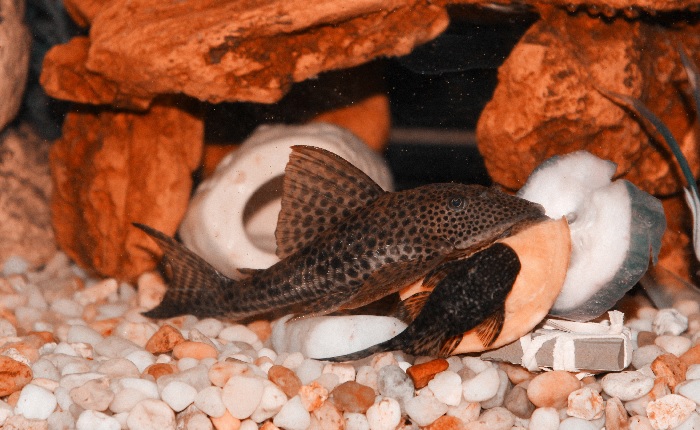Clown loaches (whose scientific name is Chromobotia Macracanthus) deserve to be crowned as one of the most peaceful freshwater creatures known to date.
Named “clowns” due to their quirky appearances and vibrant colors, they will be a terrific addition to your community tanks! Not to mention, their care and maintenance are also pretty undemanding.
Nevertheless, there are still certain questions that need answers for successful outcomes. What’s the clown loach growth rate? Is there any way to make them grow quicker? How about their living conditions?
Our insightful article will gladly discuss all these burning inquiries. Keep scrolling to learn more!
Contents
What Is The Clown Loach Growth Rate?

In most cases, clown loaches are reported to measure around 3mm at birth and reach 1 inch within the first 5-6 weeks.
Wild, full-grown loaches can grow to 16 inches or even more, with the captivity of at least 12 inches. Meanwhile, in the case of aquarium fishes, you may expect an estimation of 6 to 10 inches.
Regarding the biggest loach ever known, it seems studies and arguments vary. Nevertheless, the largest one recorded (so far) is a home aquarium loach, about 16.5 inches in length.
The concise table below should give you an overview of their average growth rates and estimated sizes throughout their life cycles until full growth.
| Age | Size (cm) | Size (inches) |
| Birth – 6 weeks | 3 mm to 2.5cm | 0.12 to 1 inch |
| 6 weeks – 1 yr | 2 cm to 7.5 cm | 0.8 to 3 inches |
| 1 – 2 yrs | 5 to 15 cm | 1.95 to 6 inches |
| 2 – 5 yrs | 5 to 16.5 cm | 1.95 to 6.5 inches |
| 5 – 10 yrs | 12.5 to 20 cm | 5 to 8 inches |
| 10+ yrs | 15 to 25.5 cm | 6 to 10 inches |
As easily observed from the cart above, once the fish achieves a length of 6 to 8 inches, its growth tends to get slower to 1.5-2 inches every year.
Whether it can reach full dimensions within the first ten years depends on numerous factors, like feeding, general health, and living conditions. Thus, estimating the exact point where fishkeepers can finally have a full-grown loach is quite challenging.
But on average, the main development occurs in the first 1 to 5 years. If well maintained, healthy loaches will keep growing further after that.
How to Speed Up The Clown Loach Growth Rate
1. Tank Setups

In the tank, consider providing varied substrates (ex: sand and pebbles) to create a more open and natural ecosystem/environment for your clown loaches.
Also, remember that subdued lighting is crucial since these loaches become much more active under the dark. You can easily achieve such lighting via floating plants like Water Spangles, Hornwort, Java Moss, and Riccia Fluitans.
Submerged bushes and plants are welcomed, too. Species like the Amazon Swords will be a lovely match for your clown loaches!
Not only do these plants provide adequate shade for the aquarium, but they also help aerate the tank with extra oxygen production. Not to mention, your fish will receive filtration layers and ample space to hide and play!
What about the water temp? Experts suggest setting the temperature close to the tolerance limits (86 degrees F). After all, clown loaches survive much longer at high temps, with little susceptibility to diseases!
And, of course, like with most tanks, buy filters and heaters to ensure the heat and temperature stay consistent even in cold weather!
On another note, don’t forget to maintain the pH level at 7.4 to 7.8 (the optimal range). Still, slight fluctuations from 7 and 8 are alright on certain occasions.
2. Diets

In wild environments, clown loaches often consume invertebrates since they are omnivorous. Cases in point are water-dwelled snails, crustaceans, and worms. Sometimes, algae and decaying plant matters are also among their favorites!
We trust that meeting these dietary requirements for your home aquariums is a piece of cake.
Professionals also suggest feeding them a combination of algae wafers and shrimp pellets from time to time. Do not worry if some of these foods sink low to the tank’s bottom; loaches are good at finding and handling leftover flakes!
If possible, we recommend you set up separate smaller tanks to breed snails as loach’s live food – your pet fish will certainly appreciate those efforts! (But otherwise, buying readily-available snails at local or online stores is okay).
How about frozen foods (like blood worms and shrimp)? Although they support the fish’s healthy growth, some studies have listed potential side effects in certain cases. Hence, to stay on the safer side, feed your loaches these delicacies once in a while! (preferably 1-2 times a week).
Regardless of what food you choose, remember to feed the loach twice a day and only a small amount for each go!
3. Mates

In aquariums, clown loaches will go well with every community fish. Examples are black widow tetras, neon tetras, tiger barbs, and cherry barbs. Large species like cichlids are sometimes welcome- they exert no aggressive behaviors and share similar water parameters.
Another popular choice is bottom-dwelling creatures: Borneo-sucking loaches, bristle nose plecos, and Kohli loaches.
All in all, we highly recommend you keep loaches in big social groups – since they are famous for pack mentality. At least five members will be the best, pushing the loaches to become more active and friendly.
Living alone, otherwise, can make loaches incredibly shy and nervous, constantly trying to hide from you! What a waste to your beautiful aquarium if the fish refuses to leave its safe place!
Conclusion
What is the clown loach growth rate? Can I foster their growth better? Our post has addressed all those common problems, citing studies and research from trustworthy sources to guarantee the best results!
Do you still have any confusion? Then write to us.

